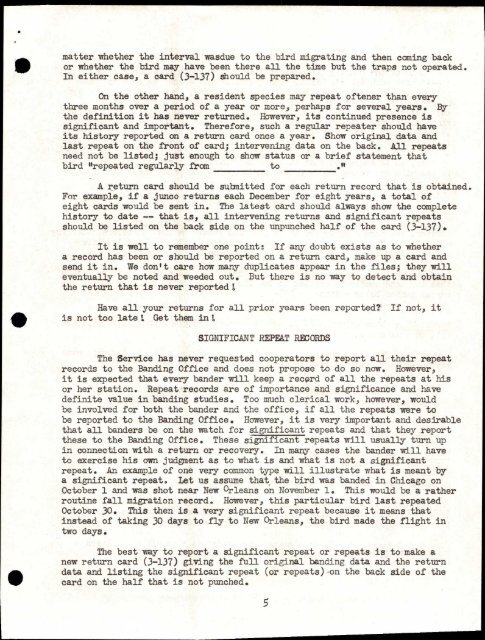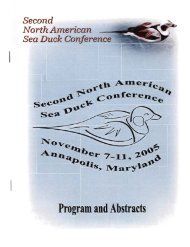BIRD BANDING NOTES - Patuxent Wildlife Research Center
BIRD BANDING NOTES - Patuxent Wildlife Research Center
BIRD BANDING NOTES - Patuxent Wildlife Research Center
Create successful ePaper yourself
Turn your PDF publications into a flip-book with our unique Google optimized e-Paper software.
matter whether the interval wasdue to the bird migrating and then coming back<br />
or whether the bird may have been there all the time but the traps not operated.<br />
In either case, a card (3-137) should be prepared.<br />
On the other hand, a resident species may repeat oftener than every<br />
three months over a period of a year or more, perhaps for several years. By<br />
the definition it has never returned. However, its continued presence is<br />
significant and important. Therefore, such a regular repeater should have<br />
its history reported on a return card once a year. Show original data and<br />
last repeat on the front of card; intervening data on the back. Aal repeats<br />
need not be listed; just enough to show status or a brief statement that<br />
bird urepeated regularly from to . 11<br />
A return card should be submitted for each return record that is obtained.<br />
For example, if a junco returns each December for eight years, a total of<br />
eight cards would be sent in. The latest card should always show the complete<br />
history to date -- that is, all intervening returns and significant repeats<br />
should be listed on the back side on the unpunched half of the card (3-137).<br />
It is well to remember one point: If any doubt exists as to whether<br />
a record has been or should be reported on a return card, make up a card and<br />
send it in. We don't care how many duplicates appear in the files; they will<br />
eventually be noted and weeded out. But there is no way to detect and obtain<br />
the return that is never reported<br />
Have all your returns for all prior years been reported? If not, it<br />
is not too late; Get them int<br />
SIGNIFICANT REPEAT RECORDS<br />
The Service has never requested cooperators to report all their repeat<br />
records to the Banding Office and does not propose to do so now. However,<br />
it is expected that every bander will keep a record of all the repeats at his<br />
or her station. Repeat records are of importance and significance and have<br />
definite value in banding studies. Too much clerical work, however, would<br />
be involved for both the bander and the office, if all the repeats were to<br />
be reported to the Banding Office. However, it is very important and desirable<br />
that all banders be on the watch for significant repeats and that they report<br />
these to the Banding Office. These significant repeats will usually turn up<br />
in connection with a return or recovery. In many cases the bander will have<br />
to exercise his own judgment as to what is and what is not a significant<br />
repeat. An example of one very common type will illustrate what is meant by<br />
a significant repeat. Let us assume that the bird was banded in Chicago on<br />
October 1 and was shot near New Orleans on November 1. This would be a rather<br />
routine fall migration record. However, this particular bird last repeated<br />
October 30. This then is a very significant repeat because it means that<br />
instead of taking 30 days to fly to New Orleans, the bird made the flight in<br />
two days.<br />
The best way to report a significant repeat or repeats is to make a<br />
new return card (3-137) giving the full original banding data and the return<br />
data and listing the significant repeat (or repeats) on the back side of the<br />
card on the half that is not punched.<br />
5












